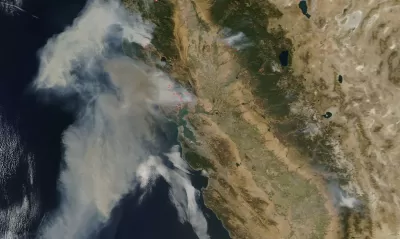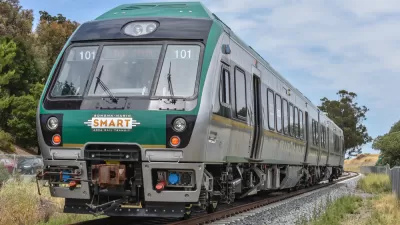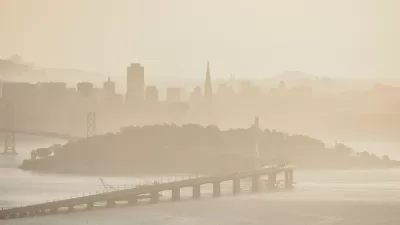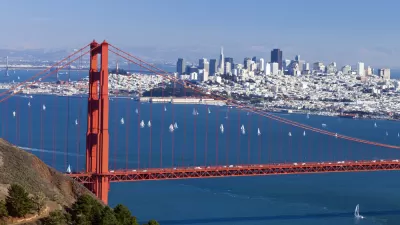The fires in Northern California have caused at least 21 deaths, with over 500 people missing in Sonoma County. Wired science editor, Adam Rogers, looks at the problems posed when urban development encroaches wildlands.

Take a video train ride through what once were Santa Rosa neighborhoods on Sonoma–Marin Area Rail Transit (SMART), courtesy of the San Francisco Chronicle, Oct. 10.
"According to CAL FIRE spokeswoman Heather Williams, 11 people have died in Sonoma County, six in Mendocino County, two in Yuba County and two in Napa County," report Phil Willon, Paige St. John, Louis Sahagun, Sonali Kohli and Chris Megerian for the Los Angeles Times on Wednesday.
"We've had big fires in the past," Gov. Jerry Brown said. "This is one of the biggest."
Cal Fire estimates that around 3,500 structures have been destroyed.
As of noon, Wednesday, over 500 people were reported missing in Sonoma County, according to the San Francisco Chronicle.
Strong winds spread the fires rapidly – which Adam Rogers, science editor for Wired, mentions in his Oct. 11 piece that looks at the wildland-urban interface (WUI).
Blame the wind, if you want. In Southern California they call it the Santa Ana; in the north, the Diablos.
No one yet knows the cause of the more than a dozen fires ablaze around California, but fires start where humans meet the wild forests, where people build for solitude or space or beauty. Things go wrong in those liminal spaces, at the interface between the wilds and the built.
The location of the WUI presents special challenges for firefighters from both sides of the interface.
“Most wildland firefighters are not trained in structural protection, but the urban fire departments are not trained to deal with dozens or hundreds of houses burning at the same time,” says Volker Radeloff, a forestry researcher at the University of Wisconsin. “When these areas with lots of houses burn, the fires become very unpredictable.”
Housing crisis exacerbates fire potential
California housing policies are more likely to push single-family houses out into the edges of communities than encourage the construction of dense city centers.
So keep thinking about blame as northern California rebuilds—if regulations get brave enough to insist on denser cities, less flammable materials, different ornamental vegetation, underground power lines.
For more focus on the WUI nexus with California's housing shortage, see August post by contributing editor Philip Rojc based on an earlier Wired article by Rogers, and September 2016 post from The Wall Street Journal.
Air Quality
The smoke from the North Bay fires have worsened air quality in San Francisco and the Peninsula, reports Amy Graff for The Chronicle.
"We're seeing the worst air quality ever recorded in many parts of the Bay Area," says Tom Flannigan, the [public information officer] for the Bay Area Air Quality Management District. "The entire Bay Area population is likely being affected by the smoke."
The wet winter and climate change may also help explain the intensity of recent fires.
More reading on wildland-urban interface:
- See August 2016 post to read how "Strategic Land Use Planning Could Lower the Cost of Wildfires."
- U.S. Forest Service publication (2013): "Wildfire, Wildlands, and People: Understanding and Preparing for Wildfire in the Wildland-Urban Interface." [pdf]:
This report by the Forests on the Edge project, sponsored by the U.S. Department of Agriculture, Forest Service is intended to heighten awareness of the ecological role and societal costs of wildfire, the causes and impacts of wildfire on human communities, and the relationship between increases in housing development and wildfire risk.
FULL STORY: The Napa Fire Is A Perfectly Normal Apocalypse

Study: Maui’s Plan to Convert Vacation Rentals to Long-Term Housing Could Cause Nearly $1 Billion Economic Loss
The plan would reduce visitor accommodation by 25,% resulting in 1,900 jobs lost.

North Texas Transit Leaders Tout Benefits of TOD for Growing Region
At a summit focused on transit-oriented development, policymakers discussed how North Texas’ expanded light rail system can serve as a tool for economic growth.

Why Should We Subsidize Public Transportation?
Many public transit agencies face financial stress due to rising costs, declining fare revenue, and declining subsidies. Transit advocates must provide a strong business case for increasing public transit funding.

How to Make US Trains Faster
Changes to boarding platforms and a switch to electric trains could improve U.S. passenger rail service without the added cost of high-speed rail.

Columbia’s Revitalized ‘Loop’ Is a Hub for Local Entrepreneurs
A focus on small businesses is helping a commercial corridor in Columbia, Missouri thrive.

Invasive Insect Threatens Minnesota’s Ash Forests
The Emerald Ash Borer is a rapidly spreading invasive pest threatening Minnesota’s ash trees, and homeowners are encouraged to plant diverse replacement species, avoid moving ash firewood, and monitor for signs of infestation.
Urban Design for Planners 1: Software Tools
This six-course series explores essential urban design concepts using open source software and equips planners with the tools they need to participate fully in the urban design process.
Planning for Universal Design
Learn the tools for implementing Universal Design in planning regulations.
City of Santa Clarita
Ascent Environmental
Institute for Housing and Urban Development Studies (IHS)
City of Grandview
Harvard GSD Executive Education
Toledo-Lucas County Plan Commissions
Salt Lake City
NYU Wagner Graduate School of Public Service





























